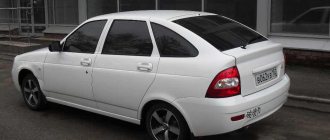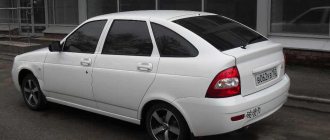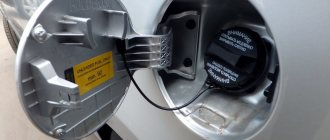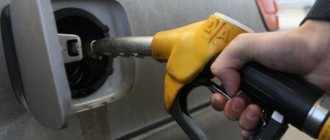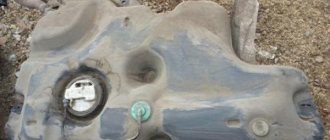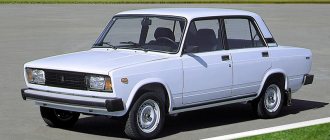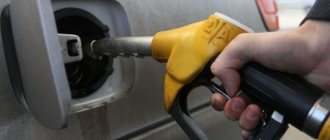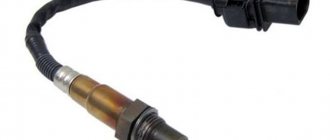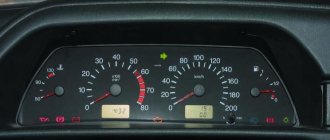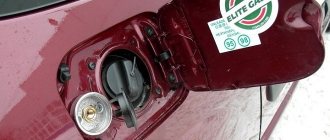VAZ 2114 LADA technical specifications
The first sales copy of the VAZ 2114 appeared in 2002. This car is a restyled “nine” and attracts Russian car enthusiasts with its modern appearance and technical capabilities for self-expression through professional tuning.
Elements of technical characteristics of the VAZ 2114
- Aerodynamic characteristics;
- Dimensions;
- Ground clearance;
- Vehicle weight;
- Basic body data;
- Chassis characteristics;
- Transmission data;
- Technical parameters of the motor.
Improved aerodynamics
The VAZ 2114 car excels in aerodynamic characteristics thanks to its well-designed body lines, providing excellent streamlining. As a result of the change in appearance, the drag coefficient has decreased.
External aerodynamic improvements of the Lada2114 Samara-2 also affected changes in the position of the air flow separation point. To do this, the designers had to change the angle of inclination of the most aerodynamically active front part of the car - the hood. The front fenders have also undergone changes.
As a result of the redistribution of the air flow, a smaller part of it is directed under the bottom, while the larger part is directed onto the hood and spreads over the body. These characteristics change the amount of total lift force, as a result of which the front and rear axles are unloaded. The even distribution of lift force allows the hatchback to behave in a balanced manner during high-speed driving.
Exterior and interior characteristics
The car's interior is equipped with a "European" instrument panel, an adjustable steering column, a new heating system and a steering wheel borrowed from the VAZ 2110 model. It is possible to turn the car into a utility vehicle; to do this, you only need to fold out the rear seat.
Additional appearance improvements and new options include:
- Installation of electric windows;
- Comfortable heated seats;
- Equipment with central door locking;
- Availability of factory tinted glass, produced in accordance with GOST;
- Providing threshold fairings, side moldings;
- Providing wheels with alloy discs;
- Availability of fog lights.
The equipment of the “luxury” Lada 2114 Samara-2 models includes an on-board computer that provides accurate information on average speed, fuel consumption, driving time, outside temperature, voltage in the on-board network and other parameters.
Modified Lada Samara
General technical specifications
Individual technical characteristics that distinguish the “fourteenth” hatchback from its predecessors are the parameters of the five-door body. Its length is 4,122 meters, width – 1,650 m, height – 1,402 m. The car differs from the base model (VAZ 21093) by a slight extension. Machine weight – 985 kg.
The wheelbase is characterized by a width of the front wheels of 1.4 meters, the rear wheels – 1.37 meters. The trunk (with the rear seat up) has a volume of 330 dm³, with the rear seat folded down – 600 dm³.
The clearance from the asphalt to the crankcase is 160 mm, to the pan the clearance is 10 mm more.
Features of the power unit
The first “fourteenth” VAZ models were equipped with injection engines characterized by a displacement of 1499 cm³ and a power of 57.2 kW. Since 2007, under the hood of the Lada 2114 Samara-2 there was a four-stroke gasoline engine with a displacement of 1599 cm³, providing a power of 59.5 kW or 80 hp. With. This engine met the parameters of the Euro 3 eco-standard. The latest modernized model with the index 211440-24 has a sixteen-valve engine with an output of 89 horsepower.
The power supply system using distributive (phased) injection provides high dynamic capabilities, ensuring acceleration to 100 km/h in just 13 seconds. The maximum speed of the VAZ 2114 is 160 km/h. At the same time, the car consumes gasoline economically - only 9 l/100 km in the city.
A special feature of the engine characteristics of this model is the original location of the ceramic catalyst - near the engine itself (unlike its predecessors, which had a catalyst under the bottom). The difference between the cylinder block of the VAZ engine of the “fourteenth” model Lada Samara-2 is its changed volume, achieved by increasing the height of each of the cylinders by 0.23 cm.
Transmission and chassis
All front-wheel drive cars of the VAZ family have a fundamentally similar chassis design. The front suspension is based on the MacPherson system, the rear suspension is a trailing arm. The steering, typical for all models, is rack and pinion.
Lada 2114 Samara-2 is equipped with a manual gearbox. The car is equipped with a five-speed gearbox (gearbox) with a rocker drive. Fundamentally, its design is similar to all those installed on other vase models. The main pair has a distinctive gear ratio of 3.7.
Video test drive
Consumption and travel distance
If we take into account the volume of the VAZ 2114 tank and the data on gasoline consumption (given in the table above), we can draw the following conclusions about the possible travel range.
When driving at a constant speed of 90 km/h, the maximum range can be almost 700 km without additional refueling.
Fuel system VAZ 2114
When traveling in the so-called “mixed” city/highway mode, consumption will increase, which means the range will decrease (up to 640 km).
And when traveling only in city mode (taking into account standing in traffic jams and a large proportion of driving in low gears), fuel consumption will be maximum - almost 10 l/100 km. It is also worth considering that these figures are for new cars. For used cars they will be slightly higher.
Tank volume and why it changes
According to the technical documentation for the VAZ-2115, this car has a fuel tank with a nominal volume of 43 liters. However, its design feature is a long neck, into which you can pour another 2 to 5 liters. There is a fierce debate among car enthusiasts over how many liters can actually be placed in the tank of a standard “tag”. Many even believe that in cold weather a larger amount of fuel can be placed in the container than on a hot summer day.
In fact, the reason for the change in the holding volume of fuel is the deformation or stretching of the tank. If the surface of this spare car part has many dents, then its capacity will decrease. Over time, some car enthusiasts begin to notice that more gasoline is placed in the tank for refueling the car; this is due to the swelling of the tank.
It is unknown what the displacement will be in the latter case, but in practice, service station specialists have encountered tanks with a capacity of 50 liters (excluding the neck).
Problems of the VAZ-2115 fuel tank
The gasoline tank on the VAZ-2115, as in any other car model, is made of metal. This material tends to stretch and compress under the influence of external forces. This is far from the only problem with fuel capacity in this car. Most often, owners of this vehicle encounter the following problems:
- fuel leakage;
- incorrect operation of the sensor;
- design flaws.
The first and last faults are often related. The fact is that in carburetor models a separator is used. This device is necessary to collect gasoline vapors and condense them. After the vapor turns into liquid, it is drained back into the tank. Most VAZ-2115s are equipped with a plastic separator, which over time becomes covered with cracks, melts and becomes deformed. In such cases, it is necessary to replace it with a metal model, which is more resistant to external influences. The injector does not have such an element in its design.
Incorrect display of the fuel level in the tank can be caused by two reasons:
- If, after starting the engine, the instrument on the panel shows different values, then you need to look for a problem in the handbrake area. There is a ground wire running through it, the fastening of which may become loose when the vehicle is used. It is enough to tighten two bolts for the problem to disappear.
- After repairs, the gasoline consumption control lamp may come on prematurely. This is due to the fact that the float sensor located in the fuel container is triggered ahead of time. At the moment when the float drops to a certain level, the contacts close. It is enough to bend the limit switch slightly so that the closure occurs a little later.
Remember that all work on the fuel system must be carried out in compliance with safety rules.
How often should you change the engine oil: opinions of car owners
- It all depends on the lubricant Tank volume for VAZ 21099
“The brand name is of great importance. Domestic cheap Lukoil is replaced every 5-6 thousand. More expensive oils have many high-quality additives: detergents, anti-aging, anti-foaming, etc. During the first tens of kilometers, the engine is cleaned under the influence of high temperature, the detergent components evaporate, and restorative additives come into play.Such oil should also not be “driven” for more than 10 thousand. The motor will constantly be washed out and, I think, will require “capitalization” faster because the layer formed by the reducing components on the metal surface will constantly be destroyed. I believe that the mileage between replacements should not exceed 10–12 thousand kilometers, and it is advisable to do maintenance after the winter season; in winter, accumulated condensate can negatively affect the properties of the oil.”
- Changing the oil is like brushing your teeth
“There is an opinion (and whether you believe it or not is up to you) that lubricants now are completely different from what they used to be, even from famous brands, and that they are all poured from the same barrel underground somewhere in Poland or Samara. Therefore, you need to change the oil and... the car more often))). Here everyone chooses their own decision. Considering today's fuel prices, replacing lubricant is not that expensive. To please your engine - is this unpleasant for a good owner? Changing your oil is like taking care of your teeth. We clean in the morning and sometimes before bed. More often does not mean better, as we wear away the enamel more; but even less often - it can lead to caries. Setting priorities is up to you personally.” - Looking for a middle ground
“How often to change the oil largely depends on how you use the car. Replacement every 5-7 thousand km is paranoia and a waste of money. The opposite extreme is to drive 500–1000 km every day and forget to change it altogether when the mileage is already under twenty. But it’s better every 10,000 km - this is a good reinsurance for our difficult Russian conditions. For example, new Kia-Sportage models have a service-to-service mileage of 15,000 km. It turns out that 10–12 thousand is the golden mean. Any lubricant - Motul, Castrol, or even our LUKOIL or Lux - will withstand this period perfectly.” - The engine runs even when the odometer does not turn
“On most public pages and auto forums, entire threads of holiwars and battles arise regarding oil changes. Manufacturers often recommend changing it every 10,000 or 15,000 kilometers. The mindset of an ignorant consumer is to follow this recommendation, because otherwise we will lose the warranty. Being under warranty service, as many people believe, means “you came, left the key, and they silently did everything right for you.”However, anyone who has actually encountered dealers knows that the “officials” have a different vision of the guarantee. As an experienced master, I can say that often the lubricant practically loses its properties after 6-7 thousand. And don’t forget that Muscovites, for example, drive their car most of the time in traffic jams, the odometer doesn’t spin, and the engine idles.”
- In any case, it is better to rely on engine recommendations ahead of schedule. It’s better to focus on the standard requirements of automakers regarding intervals and timing of maintenance.”
What to do if water gets into the tank
The volume of gasoline poured may become smaller if liquid accumulates in the tank. The parameters of the container will not change, but the composition of its contents will be different. When water gets into the tank, you can observe the following:
- difficulty starting the car in the morning;
- uneven engine operation;
- the need to warm up the car longer before starting.
Water enters the tank for various reasons. You can remove it in one of the following ways:
- Mix pure alcohol (from 200 to 500 milliliters) with gasoline, then pour these liquids into a container for fuel.
- Through the spool on the fuel rail. This is a more complicated method, since you will need to drain the liquid using a hose into any transparent container. To do this, apply voltage to the fuel pump using the diagnostic block.
- Drain manually using a long, thin hose from a drip line. You will need to place a bucket or any container under the liquid in the inspection hole or simply below the tank level.
You can prevent water from entering the gas tank by maintaining a constant fuel level in it (it is advisable to refuel “to capacity”). If you need to add gas on a rainy or foggy day, fill the fuel container 100%. This simple technique will allow you to displace moist air from the system, which settles as condensation during movement. In late autumn, pour pure alcohol into the system (200 milliliters is enough) to remove accumulated water and prevent it from freezing.
What is better antifreeze or antifreeze for VAZ
Beginning car owners of the domestic automobile industry, learning the basics of car ownership, often ask various questions about servicing and repairing VAZs.
One of the most frequently asked questions regarding the cooling system: which is better - Antifreeze or antifreeze for VAZ? The question is quite interesting and is asked often, especially from owners who purchased a car, but were unable to get a clear answer from the former owner as to what was poured into the cooling system.
And before the winter period, when car preparation is required, this question comes up and makes you think. Let's try to figure it out.
Design and location of the gas tank VAZ 2108/09/14/15
A gas tank is one of the elements of a car's fuel system. Its main and only purpose is to store a certain amount of fuel. In this case, storage is carried out as safely as possible, without leaks and fumes.
On VAZ 2108/09/14/15 cars the fuel tank is installed under the rear seat. Therefore, even in the event of a serious head-on collision, its damage will be minimal. The risk of fuel leakage and ignition will be equally minimal.
The tank volume on VAZs is 43 liters (including a reserve of 4–6 liters). This volume should be enough for the car to run autonomously for 400–600 kilometers.
The fuel tank on the VAZ 2108/09/14/15 is located under the rear seat
The gas tank on VAZ 2108/09/14/15 cars is attached to the body using two plate clamps. Fuel is poured into the tank through the neck on the right rear side of the body. Usually the neck is closed with a threaded cap.
The neck is connected to the tank cavity by a special filler tube. Inside the tank there are two drainage tubes connected through a hose to a separator - a device for collecting gasoline vapors. To prevent fuel leakage from the separator, a double-acting valve is installed on the hose, which can operate in two directions. Fuel vapor that evaporates during driving returns back to the tank and condenses. On VAZ cars, the separator holds only seven liters, but this is enough to monitor the condition of the fuel in the tank.
At the top of the gas tank there is another mandatory element of the fuel system - a fuel level sensor, which supplies information to the dashboard about the amount of gasoline in the tank. It is attached via a rubber gasket, and access to it is only possible through the rear seat in the cabin.
Fuel tanks of VAZ 2108/09/14/15 cars are made of leaded sheet steel - a strong, durable material. Traditionally, the tank container is welded from two halves and coated on the outside with dark enamel.
The metal body of the fuel tank is treated with corrosion protection and coated with black paint
Transmission and chassis of the VAZ 21093
The transmission on the VAZ 21093 is structurally made of one unit, including a clutch and a manual gearbox (MT). The gearbox is combined with a differential, the clutch is single-plate. The clutch housing is connected to the flywheel with bolts. To ensure contact with the pressure plate, six elastic plates are used.
The car's wheel drive includes two constant velocity joints (CV joints): a rod shaft on the left and a tubular shaft on the right. The front suspension of the car is independent, hydraulic shock absorbers, cylindrical springs. The rear suspension is torsion bar, independent, with a trailing arm design.
The braking system on the 21093 uses front disc brakes and rear drum brakes. There is a diagonal interaction of contours. One circuit includes the right front and left rear wheels, the other - the remaining two. The hydraulic drive of the system includes a vacuum booster and a pressure regulator for the rear brakes.
The VAZ 2109 was first produced back in 1988. The five-door design allowed this car to be used as a successful family commercial vehicle. At the same time, the car is often used for transporting small-sized cargo, as it is equipped with a fairly simple luggage compartment.
Due to the fact that the VAZ 2109 is a very practical and easy-to-maintain car, it is popular among young people. Due to its distinctive sporty look and great lightness, it is ideal for tuning enthusiasts. Modernization in this area includes not only a transformation of the appearance, but also engine tuning. Sports riding enthusiasts change the following:
- basic bumpers - for stylish sports body kits,
- install powerful, direct-flow exhaust pipes,
- standard air filters - for sports ones.
The car gains improved aerodynamic properties and increased power. But tuning fans don’t stop there and upgrade the engine in a sporty way. Today you can often find VAZ 2109 with turbine engines, which take part in street racing along with foreign cars.
Another way to tune a VAZ 2109 is to replace the car’s dashboard. In configuration, it is similar to panels of such brands as BMW 3, Mazda 626, Opel Vectra. They are so suitable in configuration that they do not undergo any modifications before installation in the “nine”. Anyone who plans to do this will replace the dashboard of any problems.
The VAZ 2109, the price of which is affordable for everyone, has proven itself well on the Russian market. And despite the fact that the production of the “nine” has completely stopped since 2011, it is still in high demand. To make the car more interesting, you will have to spend money, but after tuning it will be difficult to recognize it as a VAZ 2109.
The production of the VAZ-2109 car began in 1988 by the Volzhsky Automobile Plant. Its predecessor was the VAZ-2108, compared to which the body of the “nine” became more elongated, and there were two more doors (five). Thanks to the increased number of doors, many people used it as a family car.
The interior of the VAZ-2109 is strictly practical and claims to be comfortable. In the first case, we should note the laconic “low” dashboard, which is somehow a little convenient. The front seats have headrests. In the second case, it is worth noting the informative “high” dashboard, thanks to which you can clearly monitor the status of its on-board systems.
And thanks to the improved interior (door upholstery with rates, fabric seat upholstery), the car can acquire a more prestigious look. If you fold the rear seats, this car takes on a cargo-passenger appearance, like a station wagon.
The last cosmetic upgrade for this car was made in 1997. Since 2001, they began to produce them with injection engines. Maintenance of this car is almost as economical as for other models of the Volzhsky Automobile Plant.
https://remontvazov.com/obem-baka-vaz-2114https://avtokent74.ru/obem-baka-vaz-2114/https://automanya.ru/lada-drugoe/obem-baka-2114.htmlhttps: //vazlada.info/vaz-2109/benzobak-vaz-2109/https://vazlada.info/vaz-2109/benzobak-vaz-2109/
Basic gas tank malfunctions
The gas tank is made of strong, durable material and lasts for the entire life of the vehicle. However, in some situations it may require repair. These situations are as follows.
Fuel line clogged.
Hole in the tank.
Leak on the welding line of the tank body.
The cause of clogged hoses can be dirt getting into the fuel mesh in the tank itself. The solution in this case is quite simple - periodically wash or change this mesh.
If a hole is formed in the tank as a result of a mechanical shock, then it can no longer be repaired. In this case, the tank will need to be replaced.
If gasoline leaks from the welding line of the tank halves, you can try to seal this place. However, this procedure is very complex and requires appropriate experience.
A gas tank with extensive corrosion cannot be repaired.
Gas tank repair
Repairing a fuel tank is usually not very difficult. Much here depends on the nature of the damage and the skills of the car owner. Small holes in the case can simply be soldered, but large damage will require the use of a welding machine.
The tank itself does not always need welding or repair. On VAZ 2108/09/14/15 vehicles, the tank fastening elements or its components (for example, the neck or studs) often fail. Such malfunctions need to be eliminated urgently - the safety of fuel storage in the tank is largely determined by its fastening, position relative to the body axis and tightness.
Required tools and accessories
Removing the gas tank is carried out using a standard set of tools: wrenches of different sizes, a screwdriver and a hammer in case any element is difficult to dismantle.
To wash, clean and repair the tank you will need:
container for draining fuel;
tire pump for supplying compressed air;
hose connected to a hot water supply;
